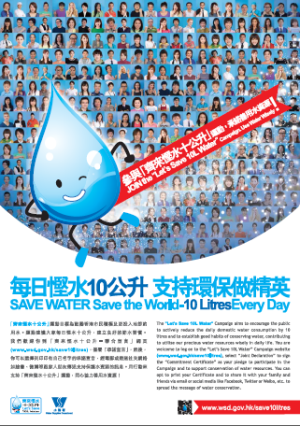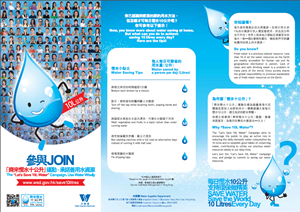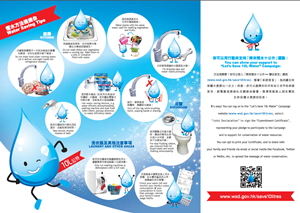Save 10 litres of water every day to prepare for the unexpected
|
“Take fewer showers. Shower only once a day and wash your hair once every two weeks. Avoid wearing white clothing and don’t wash or change your clothes too often. Don’t take baths. If you have to use the bathtub, don’t fill it more than six inches deep – it would be even better if all family members use the bathtub together. Do you find the above water-saving methods strange? They are, in fact, the water-saving methods initiated by Hong Kong people during the water rationing period from 1963 to 1964. You may have heard the elder generation in your family talk about the days when they had to yell at the neighbours downstairs to turn off the taps. How much do you know about what was going on at that time? In those years of water shortage, when Hong Kong’s new water supply works had still not been completed, our reservoir storage had dropped to just 1.7 per cent of total capacity due to low rainfall. As a result, the Government had to implement water rationing measures by providing water for only four hours every four days for an entire year. Naturally, people’s daily lives and our economy were adversely affected by the shortage. Crops, for instance, withered due to drought conditions, and there was huge loss of livestock and poultry; businesses faced production losses or interruption in both the commercial and service sectors, and workers’ incomes were reduced. Deteriorating public hygiene also led to the outbreak of cholera and dysentery, further highlighting the negative impact of water shortages. These unforgettable experiences for our elder generations are totally unfamiliar to those born after the 1970s and 1980s. Some of the water-saving methods mentioned above are simply unimaginable, but they demonstrated the admirable spirit of the Hong Kong people at the time, who joined together to save water. With the completion of Plover Cove Reservoir and High Island Reservoir and the implementation of our seawater system for flushing, plus the signing of an agreement with the Guangdong Provincial Government to import Dongjiang water to the territory, water rationing measures have not been implemented in Hong Kong since 1982. So today we can enjoy a steady supply of tap water. Many people, however, take it for granted that fresh water “comes by itself” and seem to think its supply is unlimited. Water is a precious natural resource. Less than 2.5 per cent of the water resources on earth are fresh water, and less than 1 per cent can be used directly by us. The exponential growth of the world’s population and economic activity, as well as the impact of climate change, pose serious threats to the Earth’s limited water resources. To better cope with unpredictable changes in future, we need to explore more water resources while finding ways to save water. Firstly, regarding the search for more water resources, the Water Supplies Department (WSD) has launched a number of programmes, including a study on the development of seawater desalination, the expansion of the seawater flushing network, and the implementation of “grey water” recycling and rainwater harvesting initiatives. While the Government will take a leading role in exploring water resources, we should do our part to save water. If we all support the Government’s water-saving initiatives and slightly adjust our daily habits of using water, our water consumption can be significantly reduced. The household average daily domestic fresh water consumption per capita amounts to 130 litres. Our overall daily water consumption per capita, which includes some 90 litres of flushing water, is more than that of other cities such as Singapore and London. Hong Kong’s overall average daily water consumption is about 3.3 million cubic metres, which would fill up the main swimming pool of Victoria Park 1 300 times. To change our daily habits of using water, we do not have to go so far as those stringent methods back in the days of water rationing. In fact it is easy to save water without affecting our quality of life if we pay more attention to small details in our daily life. For example, 10 litres of water can be saved by reducing our shower time by one minute; 26 litres of water can be saved by a family of four if they turn off the taps while brushing teeth or shaving; and 14 litres of water can be saved every day if we clean vegetables and fruits by immersing them in water instead of rinsing them under running water. Water shortage is not confined to a certain region or a single generation. It is a persistent problem affecting the whole world. As a citizen of the world, every one of us has the responsibility to treasure these precious water resources and ensure their sustainability. Water has its own natural cycle. We should strive to protect water resources by not wasting or polluting them, and ensure that they are recyclable and sustainable so that our next generation can enjoy clean and sufficient water resources without experiencing the need for water rationing. The WSD launched the “Let’s Save 10L Water” Campaign on May 17. I hope that we can all make a commitment to save 10 litres of water per person every day as first step towards forming good water-saving habits. To encourage your participation, the WSD will give away a pair of complimentary flow controllers to each participating household (while stocks last) to help save water. Details of the campaign can be found on the website (https://www.waterconservation.gov.hk/en/save-water) or in the promotion leaflets. You can also click on the hyperlink (https://www.waterconservation.gov.hk/en/home/index.html) to see a demonstration video of how to install the flow controllers. SAVE WATER Save the World – 10 Litres Every Day. |
|
18 May, 2014
Back

